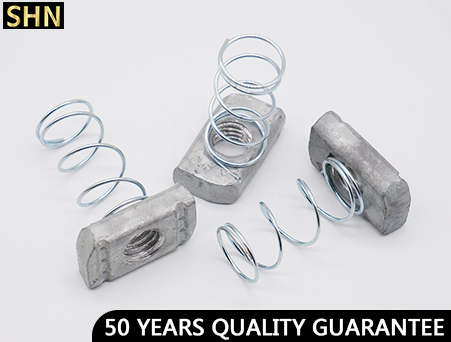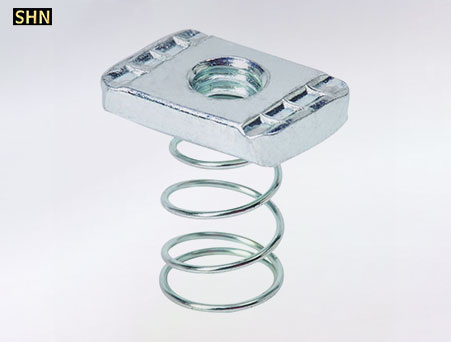+86 10 5248 4022
+86 18518927929

Mar. 19, 2024
When it comes to constructing robust structures or installing heavy equipment, understanding the weight capacity of Unistrut nuts becomes crucial. These small but pivotal components play a significant role in providing support and stability.

Unistrut nuts are engineered with durability and strength in mind. Typically made from materials like steel or stainless steel, they feature a threaded design that allows them to securely fasten to Unistrut channels. This design ensures uniform weight distribution, enhancing their load-bearing capabilities.
Unistrut nuts are commonly crafted from high-quality materials such as galvanized steel or stainless steel. These materials offer exceptional strength and corrosion resistance, making them suitable for diverse environments and applications. The choice of material depends on factors like environmental conditions and load requirements.
Yes, Unistrut nuts come in various types and sizes, each tailored to specific load capacities and applications. From standard nuts to heavy-duty variants, customers can choose the most suitable option based on their project requirements. Additionally, specialized coatings or treatments may further enhance their load-bearing capabilities.
Smaller Unistrut nuts, such as those with M6 or M8 threads, are commonly used for lighter loads. Their weight capacities typically range from a few hundred pounds to several thousand pounds, depending on factors like material, size, and installation method. It's crucial to consult load tables and engineering specifications to ensure proper selection.
Yes, larger Unistrut nuts, such as those with M10 or M12 threads, are designed to accommodate heavier loads. Their robust construction and larger thread sizes enable them to withstand greater forces and provide enhanced support. However, proper installation and load distribution remain essential for maximizing their performance.
In some cases, Unistrut nuts can be customized or modified to meet specific weight requirements. This may involve using thicker materials, altering thread designs, or incorporating reinforcement features. Customization allows for tailored solutions to unique challenges, ensuring optimal performance in demanding applications.

Load distribution plays a crucial role in maximizing the weight capacity of Unistrut nuts. Evenly distributing weight across multiple nuts and channels helps prevent overloading and minimizes stress concentrations. Proper spacing, alignment, and tightening of nuts are essential to ensure uniform load distribution and avoid premature failure.
Several best practices can help achieve optimal load distribution with Unistrut nuts. Firstly, ensure that nuts are spaced evenly along the length of the channel, following manufacturer guidelines and engineering recommendations. Secondly, utilize compatible hardware, such as washers and bolts, to distribute loads effectively and reduce point loading. Finally, inspect installations regularly to identify any signs of uneven loading or structural issues.
Yes, engineers and designers often use calculations and formulas to determine the optimal load distribution for Unistrut nuts. These calculations consider factors such as channel spacing, nut spacing, load magnitude, and structural constraints. By performing detailed analyses, stakeholders can ensure that loads are distributed safely and efficiently, minimizing the risk of overloading or structural failure.
Testing procedures for determining the weight capacity of Unistrut nuts typically involve subjecting them to various load conditions in controlled environments. These tests assess factors such as static and dynamic loading, shear strength, and resistance to deformation. Additionally, manufacturers may conduct accelerated aging tests to evaluate long-term durability and performance.
Yes, several industry standards and certifications govern the weight-bearing capabilities of Unistrut nuts. Organizations like ASTM International and the International Organization for Standardization (ISO) establish guidelines for testing methods, performance criteria, and quality assurance. Compliance with these standards ensures that Unistrut nuts meet rigorous safety and reliability requirements.
Customers can verify the reliability and safety of Unistrut nuts by checking for relevant certifications, such as ASTM or ISO compliance. Additionally, they can review test reports and technical specifications provided by manufacturers to confirm performance claims. Collaborating with reputable suppliers who prioritize quality assurance and product testing is essential for ensuring the suitability of Unistrut nuts for specific applications.
Environmental exposure, including factors like moisture, temperature fluctuations, and corrosive substances, can significantly impact the durability of Unistrut nuts. Galvanized steel nuts offer enhanced corrosion resistance compared to untreated steel, making them suitable for outdoor or high-humidity environments. Proper maintenance practices, such as regular inspection and cleaning, can also prolong the lifespan of Unistrut nuts in challenging conditions.
Certain conditions, such as improper installation, overloading, or structural defects, can reduce the weight capacity of Unistrut nuts. Insufficient tightening of nuts, misalignment of channels, or inadequate support structures can compromise their load-bearing capabilities and increase the risk of failure. It's essential to adhere to manufacturer recommendations and industry best practices to mitigate these risks effectively.
To maintain optimal performance, preventive measures should be implemented throughout the lifespan of Unistrut nuts. This includes regular inspections to detect signs of wear, corrosion, or damage, as well as prompt replacement of worn or defective components. Additionally, applying protective coatings or corrosion inhibitors can help extend the service life of Unistrut nuts in harsh environments. By prioritizing proactive maintenance and monitoring, users can maximize the reliability and longevity of their installations.
Customers can determine the appropriate size and type of Unistrut nuts by evaluating various factors, including the magnitude and distribution of loads, environmental conditions, and structural requirements. Consulting load tables, engineering specifications, and design guidelines provided by manufacturers can help identify the most suitable nuts for specific applications. Additionally, seeking guidance from experienced professionals or structural engineers can ensure accurate selection and optimal performance.
Yes, several considerations beyond weight capacity influence the selection of Unistrut nuts for a particular application. Factors such as compatibility with other components, ease of installation, and resistance to corrosion or environmental degradation are essential considerations. Additionally, factors like vibration resistance, fire resistance, and electrical conductivity may be relevant in specialized applications, necessitating careful evaluation of product specifications and performance attributes.
Unistrut nuts are versatile components that can be used in a wide range of applications, including construction, infrastructure, utilities, and industrial installations. However, adapting Unistrut nuts to specific applications may require modifications or additional accessories to address unique challenges. For example, in seismic or high-wind regions, seismic bracing or wind reinforcement may be necessary to enhance structural stability. Similarly, in corrosive environments, selecting corrosion-resistant materials or applying protective coatings can prolong the lifespan of Unistrut nuts. By understanding the specific requirements of each application and leveraging appropriate solutions, customers can optimize the performance and longevity of their installations.
Several methods can be employed to increase the weight capacity of Unistrut nuts and enhance overall structural performance. One approach is to use larger or heavier-duty nuts with increased load-bearing capabilities. Additionally, reinforcing Unistrut channels with additional supports or bracing can distribute loads more effectively and reduce stress concentrations. Strengthening connections with supplementary hardware, such as washers or locking devices, can also improve the stability and load-carrying capacity of Unistrut assemblies.
Yes, various supplementary products and accessories complement Unistrut nuts for heavy-duty applications, providing additional reinforcement and support. For example, strut braces, angle brackets, and channel connectors can enhance structural rigidity and stability in high-load environments. Threaded rods, anchor bolts, and expansion anchors enable secure attachment to substrates and facilitate versatile installation options. Additionally, specialized fasteners, such as spring nuts or strut clamps, offer secure and adjustable connections for accommodating dynamic loads or structural adjustments.
Optimizing the performance of Unistrut nuts in high-load scenarios requires careful planning, proper installation techniques, and proactive maintenance practices. Utilizing load distribution methods, such as spreading loads over multiple nuts and channels, helps prevent localized stress concentrations and minimizes the risk of overloading. Regular inspections and monitoring allow for early detection of signs of wear, fatigue, or structural deterioration, enabling timely intervention and maintenance. By implementing appropriate reinforcement strategies and adhering to best practices, customers can ensure the reliable and resilient performance of Unistrut nuts in demanding applications.
Calculating the maximum weight capacity of Unistrut nuts involves considering several factors, including the size and material of the nuts, the type and size of the channel, the method of installation, and the anticipated load conditions. Typically, manufacturers provide load tables and engineering data that specify the maximum allowable loads for different configurations and scenarios. By referencing these resources and applying relevant formulas or calculations, customers can determine the maximum weight capacity of their Unistrut nut assemblies accurately.
Yes, Unistrut nuts are suitable for overhead installations when properly installed and secured according to manufacturer guidelines and engineering specifications. However, it's essential to consider factors such as load distribution, structural integrity, and safety regulations when designing and implementing overhead support systems. Utilizing appropriate hardware, such as locking nuts or safety cables, can enhance the stability and reliability of overhead installations, mitigating the risk of accidents or structural failures.
While Unistrut nuts are compatible with a wide range of materials commonly used in construction and industrial applications, certain limitations may apply depending on specific factors such as material properties, surface conditions, and environmental exposure. For example, Unistrut nuts may have different compatibility requirements for supporting materials like steel, aluminum, or plastic, based on factors such as weight, shape, and surface finish. Additionally, considerations such as temperature extremes, chemical exposure, and mechanical stress may influence material compatibility and require careful evaluation during the design and selection process.
Understanding Strut Nuts: What Size Fits Your Needs?
Mar. 19, 2024Understanding Spring Nuts: Your Ultimate Guide
Mar. 19, 2024How to Secure Unistrut to Steel: A Comprehensive Guide
Mar. 15, 2024Leave Message
Write down your urgent needs to get free samples, and to check our stocks

Copyright © SS&HN INDUSTRY GROUP Ltd. All Rights Reserved | Sitemap | Powered by 